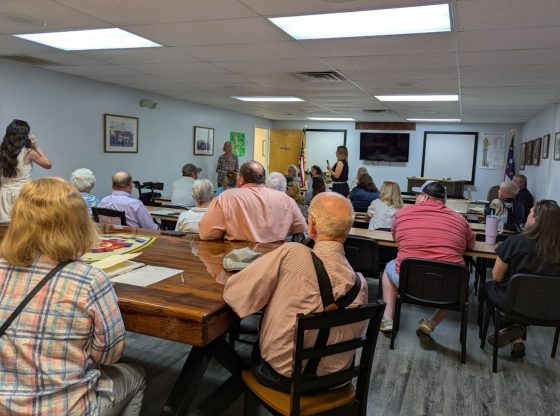Moore County Board of Commissioners held a special meeting on Sept. 1 to discuss potential uses of the $19,594,757 from American Rescue Plan Act funds (ARPA). These funds are from the Local Fiscal Recovery Funds (LFRF) directly from the U.S. Treasury.
Moore County has received half of these funds and will receive the other half next June.
Local governments have until Dec. 31, 2024, to specify fund uses and until Dec. 31, 2026, to spend the money.
State legislators are still working on the distribution and approved uses of $5.4 billion in State Fiscal Recovery Funds (SFRF) for infrastructure projects. These projects include broadband, water, sewer, wastewater infrastructure, community development, food and business support.
The use of the SFRF relies on the determination of the General Assembly to become law.
The Moore County Board of Commissions invited North Carolina Pandemic Recovery Office (NCPRO) specialists to present an overview of the funds and uses.
LFRF helps address COVID-19 response, including assistance to households, small businesses, and nonprofits. It provides premium pay to essential workers during a public health emergency.
NCPRO Program Analyst Adam Shull said vaccine programs are eligible for LFRF, but vaccine programs cannot be coercive in nature.
Moore County Commissioner Chair Frank Quis asked if the funds may be used as an incentive to vaccinate.
NCPRO Policy Analyst Nate Halubka said they had not collected enough feedback on best practices to best answer.
LFRF helps with loss of revenue due to the pandemic. The funds help with infrastructure investments in water, sewer, and broadband.
LFRF may address public health, including funding community health workers to help the community with health services. LFRF may be used for helping those who locate and apply for federal, state and local public benefits for learning services. It may be used to help with housing services connected to mental and physical wellness and for addressing homelessness. It may be used for removing lead and other hazards to promote healthy childhood environments and for new or expanding supportive care for children. It may be used for violence prevention programs.
Uses of LFRF specific to the census include helping the community access health services and funding those who help the community find health services. The census helps with the violence prevention programs based on where data dictates the most need. It addresses housing where census data directs the most need, and census data directs where childhood educational programs need to be focused.
NCPRO offers an interactive map on its website concerning census data. Moore County is Region 6.
Halubka said because a certain “category is listed, they are sort of saying it is allowable,” such as food assistance. People who have been more impacted by the pandemic, such as seniors and the impoverished, are more likely to be qualified.
Qualified Census Tracts shows presumption of broad latitude use.
Municipalities do not have to use funds only in qualified census tract areas.
Moore County is in Tier 3 on the level of social detriment to health issues, which is good, but Nate said some areas are below, such as homes where income is 60% below average.
There is some allowability to use funds where jobs were lost, such as in the leisure and hospitality sector. Small business programs are allowable.
Halubka said monthly job growth is rebounding, but the growth is slow. Recent graduates are having trouble finding jobs in their fields, and workers eligible to retire are choosing to retire rather than risk COVID-19 exposure.
Below is a North Carolina Pandemic Recovery Office video with Nate Halubka on eligibility. The video is from the NCPRO’s website.
Moore County Public Works Department Director Randy Gould said the Thurlow booster pump station estimate of $1,173,568 may be low and needs to be completed this year. The Vass water line extensions and upgrades, the Pinehurst sewer rehabilitation and the Lake Forest sewer rehabilitation also need to be completed this year. The total for all projects is $1,611,673.
Between 20 and 30 maintenance holes need to be replaced in Pinehurst.
The list of projects needing completion by 2025 totals $6,557,568.
By 2037, the current water systems will not be able to meet daily maximum water demands.
“The Deep River Water Source Project is the biggie,” Gould said.
The Water Pollution Control Plant in Addor was built in the 70s and needs $1,396,000 in repairs, replacements and engineering upgrades this year.
By 2025, the Water Pollution Control Plant needs $4,490,000 in repairs, replacement, and upgrades.
By 2027, Gould said there will need to be an engineering study on expanding the Water Pollution Control Plant.
Moore County Commissioner Catherine Graham said using the funds for the water facility would serve all citizens.
Moore County Information Technology Director Chris Butts gave a presentation on broadband expansion. He said the FCC’s standard for upload is low at 3 Mbps.
“It takes more speed to upload when video conferencing,” Butts said.
Fiber is the ultimate transmitter cable, and Butts said it lasts in the ground for decades.
Moore County Commissioner Louis Gregory said he wants to ensure schools have access to the internet, and it is a critical component.
Halubka said schools receive some direct funding that may be used for broadband.
CARES Act or ARP Act fund recipients may contact NCPRO at (984) 236-0795.
Looking for personal financial assistance due to pandemic or have questions about the HOPE program? Visit ReBuild NC’s HOPE Program page or call 888-927-5467.
Report misuse of funds to the Office of Internal Audit, 20320 Mail Service Center, Raleigh, NC, 27699-0320. Email: [email protected].
Follow NCPRO on FACEBOOK https://www.facebook.com/NC-Pandemic-Recovery-Office-101981498354371/
The commissioners plan to schedule a work session to continue the overview of possible uses of funds.
~Article by Sandhills Sentinel Reporter Stephanie M. Sellers. Contact her at [email protected].
Feature photo by Sandhills Sentinel Photographer John Patota.



















